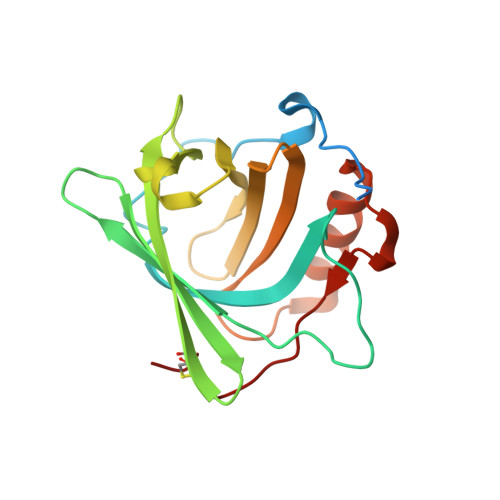The siderocalin/enterobactin interaction: a link between mammalian immunity and bacterial iron transport.
Abergel, R.J., Clifton, M.C., Pizarro, J.C., Warner, J.A., Shuh, D.K., Strong, R.K., Raymond, K.N.(2008) J Am Chem Soc 130: 11524-11534
- PubMed: 18680288
- DOI: https://doi.org/10.1021/ja803524w
- Primary Citation of Related Structures:
3BY0, 3CBC - PubMed Abstract:
The siderophore enterobactin (Ent) is produced by enteric bacteria to mediate iron uptake. Ent scavenges iron and is taken up by the bacteria as the highly stable ferric complex [Fe (III)(Ent)] (3-). This complex is also a specific target of the mammalian innate immune system protein, Siderocalin (Scn), which acts as an antibacterial agent by specifically sequestering siderophores and their ferric complexes during infection. Recent literature suggesting that Scn may also be involved in cellular iron transport has increased the importance of understanding the mechanism of siderophore interception and clearance by Scn; Scn is observed to release iron in acidic endosomes and [Fe (III)(Ent)] (3-) is known to undergo a change from catecholate to salicylate coordination in acidic conditions, which is predicted to be sterically incompatible with the Scn binding pocket (also referred to as the calyx). To investigate the interactions between the ferric Ent complex and Scn at different pH values, two recombinant forms of Scn with mutations in three residues lining the calyx were prepared: Scn-W79A/R81A and Scn-Y106F. Binding studies and crystal structures of the Scn-W79A/R81A:[Fe (III)(Ent)] (3-) and Scn-Y106F:[Fe (III)(Ent)] (3-) complexes confirm that such mutations do not affect the overall conformation of the protein but do weaken significantly its affinity for [Fe (III)(Ent)] (3-). Fluorescence, UV-vis, and EXAFS spectroscopies were used to determine Scn/siderophore dissociation constants and to characterize the coordination mode of iron over a wide pH range, in the presence of both mutant proteins and synthetic salicylate analogues of Ent. While Scn binding hinders salicylate coordination transformation, strong acidification results in the release of iron and degraded siderophore. Iron release may therefore result from a combination of Ent degradation and coordination change.
- Department of Chemistry, University of California, Berkeley, California 94720-1460, USA.
Organizational Affiliation:





















